Godzilla Conquers the Globe:
Japanese Movie Monsters in International Film Art
Exhibition Room #1: Main Reading Room
Larger Than Life
C. V. Starr East Asian Library, Columbia University, February - December 2004
Curated by Gregory M. Pflugfelder with the assistance of Yoshiko Fredisdorf, Ria Koopmans-de Bruijn, and Derek
Lam
Exhibit map, Room #1:
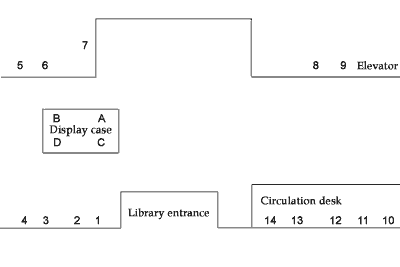
Display
Case A
(objects from the collection of Gregory M. Pflugfelder) [As of 10 September 2004, these objects have been
moved to Display
Case 1 in the Rare Book Reading Room.]
GODZILLA IN NEW YORK
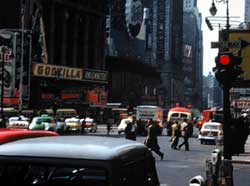 Godzilla, King of the Monsters opened at Loew's State Theater in Times
Square on 4 April 1956, and ran for three weeks (see photograph at right).
"Several episodes are banzai-worthy," reported columnist and New York institution
Walter Winchell (U.S.
pressbook, 1956). Although in the previous year at least one Japanese-language
theater in Los Angeles had screened the original version of the film, Gojira (1954), the movie about which Winchell and others raved was an adapted version
tailored for U.S. and international audiences by Jewell Enterprises, whose
only previous hit was the 1952 Untamed Women
Godzilla, King of the Monsters opened at Loew's State Theater in Times
Square on 4 April 1956, and ran for three weeks (see photograph at right).
"Several episodes are banzai-worthy," reported columnist and New York institution
Walter Winchell (U.S.
pressbook, 1956). Although in the previous year at least one Japanese-language
theater in Los Angeles had screened the original version of the film, Gojira (1954), the movie about which Winchell and others raved was an adapted version
tailored for U.S. and international audiences by Jewell Enterprises, whose
only previous hit was the 1952 Untamed Women 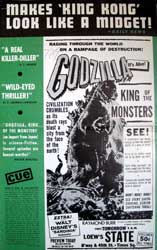 ("SAVAGE BEAUTIES
WHO FEARED NO ANIMAL... YET FELL BEFORE THE TOUCH OF MEN!"). U.S. director
Terry Morse shot a day's worth of new footage, creating a role for Raymond
Burr—fresh from a "fine performance as the killer in 'Rear Window'
[1954]"—as an American news reporter who happens to be in Tokyo at
the time of Godzilla's assault (U.S.
lobby card, 1956). New York's first view of Godzilla would not be its
last. Kaijû sôshingeki (1968; Destroy All Monsters, 1969)
had Godzilla attacking midtown Manhattan from the East River (West
German lobby card, 1971). In 1976, the American distributors of Gojira
tai Megaro (1973; Godzilla vs. Megalon, 1976) poised the title
monsters atop the recently built World Trade Center—even though no
such scene appeared in the movie itself (U.S. pressbook, 1976). And in 1998,
TriStar Pictures would produce a thoroughly Americanized Godzilla,
starring Matthew Broderick, in which the giant lizard makes her (sic)
nest in Madison Square Garden.
("SAVAGE BEAUTIES
WHO FEARED NO ANIMAL... YET FELL BEFORE THE TOUCH OF MEN!"). U.S. director
Terry Morse shot a day's worth of new footage, creating a role for Raymond
Burr—fresh from a "fine performance as the killer in 'Rear Window'
[1954]"—as an American news reporter who happens to be in Tokyo at
the time of Godzilla's assault (U.S.
lobby card, 1956). New York's first view of Godzilla would not be its
last. Kaijû sôshingeki (1968; Destroy All Monsters, 1969)
had Godzilla attacking midtown Manhattan from the East River (West
German lobby card, 1971). In 1976, the American distributors of Gojira
tai Megaro (1973; Godzilla vs. Megalon, 1976) poised the title
monsters atop the recently built World Trade Center—even though no
such scene appeared in the movie itself (U.S. pressbook, 1976). And in 1998,
TriStar Pictures would produce a thoroughly Americanized Godzilla,
starring Matthew Broderick, in which the giant lizard makes her (sic)
nest in Madison Square Garden.
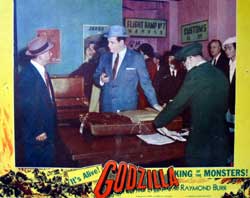 |
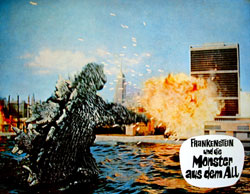 |
Display Case B
(objects from the collection of Gregory M. Pflugfelder) [As of 10 September 2004, these objects have been
moved to Display
Case 2 in the Rare Book Reading Room.]
GODZILLA IN THE WORLD
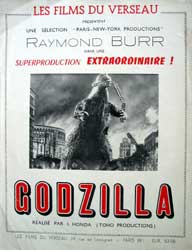 From the very beginning, Godzilla was a global citizen. Within a year of
its American debut, Godzilla, King of the Monsters had played on
five continents as well as on both sides of the Iron Curtain (French
publicity flyer, 1957; Mexican
lobby card,
1959; Polish
theater program, 1957; Spanish herald,
1957?). It is unclear when the movie was first shown in Africa. Theaters
in Tunisia, however, were definitely screening French versions of kaijû
eiga by the late 1960s (Tunisian lobby cards, 1967). Kaijûtô no kessen: Gojira no musuko (1967; Son of Godzilla, 1969) is known to have played also in Egypt. A piece
of trivia: In the 1956 Godzilla, King of the Monsters, Raymond Burr's
character, Steve Martin, is on his way to Cairo on a journalistic mission
but gets
From the very beginning, Godzilla was a global citizen. Within a year of
its American debut, Godzilla, King of the Monsters had played on
five continents as well as on both sides of the Iron Curtain (French
publicity flyer, 1957; Mexican
lobby card,
1959; Polish
theater program, 1957; Spanish herald,
1957?). It is unclear when the movie was first shown in Africa. Theaters
in Tunisia, however, were definitely screening French versions of kaijû
eiga by the late 1960s (Tunisian lobby cards, 1967). Kaijûtô no kessen: Gojira no musuko (1967; Son of Godzilla, 1969) is known to have played also in Egypt. A piece
of trivia: In the 1956 Godzilla, King of the Monsters, Raymond Burr's
character, Steve Martin, is on his way to Cairo on a journalistic mission
but gets 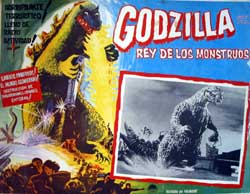 delayed by the Godzilla crisis during a Tokyo stopover. Perhaps
if Martin had made it to Egypt, he would have witnessed the outbreak of
another incident of global proportions: the Suez Crisis, which erupted in
July of the same year.
delayed by the Godzilla crisis during a Tokyo stopover. Perhaps
if Martin had made it to Egypt, he would have witnessed the outbreak of
another incident of global proportions: the Suez Crisis, which erupted in
July of the same year.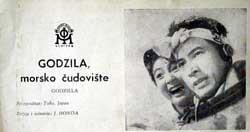
Display Case C
(objects from the collection of Gregory M. Pflugfelder) [As of 10 September 2004, these objects have been
moved to Display
Case 3 in the Rare Book Reading Room]
THE TÔHÔ POSSE (I)
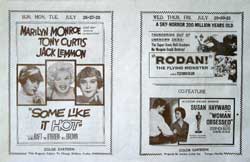
Even monsters have friends (not to mention enemies). As the
kaijû eiga genre boomed during the 1950s and 1960s, a growing stable of rubbery creatures
joined Godzilla in the movie-monster pantheon. The first newcomer was Angiras,
a spiny-backed saurian who faced the Big G in the 1955 film
Gojira no
gyakushû (
Gigantis, the Fire Monster, 1959; U.S.
lobby card, 1959; French
photostory, 1964). U.S. publicists chose to rename Godzilla "Gigantis"
when the movie premiered stateside, evidently hoping to create the impression
that the movie debuted two new monsters, not just one.
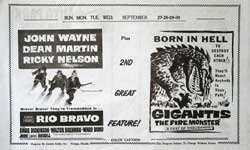
In 1956 came the
pterodactyl-like Rodan, the first Technicolor
kaijû. Japanese
know this flying lizard even today as Radon—as in "radiation," the
destructive force that originally caused his portentous appearance (Japanese
poster reproduction). An alternative etymology derives the dinosaur-bird's
name from the prehistoric pteRADON. The film's exporters, possibly fearing
that the name Radon could be taken as a criticism of the U.S. atomic-weapons
program, changed it by switching the order of the vowels
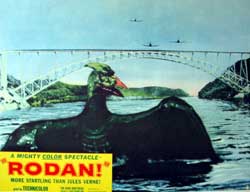
(U.S.
lobby card,
1957). In North America, movies like
Gigantis and
Rodan,
the
Flying Monster quickly became staple fare for drive-in theaters (U.S.
drive-in theater programs [1][2],
Florida, both 1959?). One theater owner in the South deemed
Rodan appropriate Christmas viewing (U.S.
theater program, Florida, 1963?).
Display Case D
(objects from the collection of Gregory M. Pflugfelder) [As of 10 September 2004, these objects have been
moved to Display
Case 4 in the Rare Book Reading Room.]
THE TÔHÔ POSSE (II)
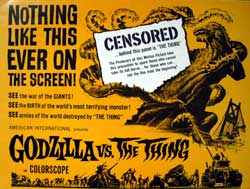 It was as Rodan, not Radon, that German and other European, as well as Australian
and Latin American, viewers came to know the monstrous flying lizard (West
German theater program, 1958?). The perennially popular Mothra, who
debuted in 1961, was also a creature of many names. Italians called the
giant moth Watang (see Poster #11), whereas American promoters
dropped Mothra's name entirely from the 1964 feature Mosura tai Gojira,
retitling it Godzilla vs. the Thing and giving the behemoth butterfly
some rather unlikely tentacles in publicity materials (U.S.
lobby card and pressbook,
both 1964).
It was as Rodan, not Radon, that German and other European, as well as Australian
and Latin American, viewers came to know the monstrous flying lizard (West
German theater program, 1958?). The perennially popular Mothra, who
debuted in 1961, was also a creature of many names. Italians called the
giant moth Watang (see Poster #11), whereas American promoters
dropped Mothra's name entirely from the 1964 feature Mosura tai Gojira,
retitling it Godzilla vs. the Thing and giving the behemoth butterfly
some rather unlikely tentacles in publicity materials (U.S.
lobby card and pressbook,
both 1964). 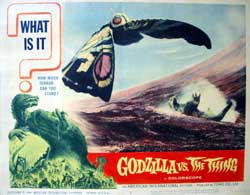 The Tôhô universe was also populated by more forgettable creatures,
including Hedora the "Smog Monster," introduced in 1971 (U.S.
pressbook,
1972). The environmentalist message that this sludgelike mass helped to
convey ("Save the Earth" was the movie's rock-anthem theme song) marked
a shift away from the antinuclear themes of the 1950s and the critique of
commercialism that had dominated the kaijû eiga genre during the
1960s.
The Tôhô universe was also populated by more forgettable creatures,
including Hedora the "Smog Monster," introduced in 1971 (U.S.
pressbook,
1972). The environmentalist message that this sludgelike mass helped to
convey ("Save the Earth" was the movie's rock-anthem theme song) marked
a shift away from the antinuclear themes of the 1950s and the critique of
commercialism that had dominated the kaijû eiga genre during the
1960s.
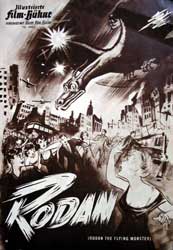 |
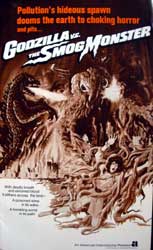 |
Poster #1
| FILM TITLE (JAPANESE): |
Kaijû
daisensô |
| (ENGLISH): |
Monster Zero |
| ORIGINAL
YEAR OF RELEASE: |
1965 |
| POSTER NATIONALITY: |
Italy |
| YEAR: |
? |
| DIMENSIONS: |
approximately
55 x 77 inches |
| PRINTING
METHOD: |
offset |
| MONSTERS
FEATURED (LEFT TO RIGHT): |
Rodan,
Godzilla |
(from the collection of Gregory M. Pflugfelder) |
|
 |
With this 1965 Tôhô feature, Godzilla
entered the space race. The Italian two-panel poster depicts Godzilla
and Rodan as they are being transported from Earth to "Planet X" encased
in transparent spheres and towed by X-ite flying saucers. On the besieged
Planet X, the two monsters face the three-headed space dragon Ghidrah.
Although the film's director, Honda Ishirô, had previously made several
space features at Tôhô, such as Chikyû bôeigun (1957; The
Mysterians, 1959), Uchû daisensô (1959; Battle in Outer
Space, 1960), and Yôsei Gorasu (1962; Gorath, 1964),
Godzilla movies had until this point remained a strictly terrestrial
genre. But as the space race got into full swing during the 1960s,
it was inevitable that Godzilla would not stay earthbound. The fearsome
lizard increasingly assumed a role as earth's defender against interplanetary
foes, rather than as humankind's mortal enemy. Kaijû daisensô marked the second foray into the kaijû eiga genre by American
actor Nick Adams (presumably the helmeted face on the right); he had
already appeared in Tôhô's Furankenshutain tai chitei kaijû Baragon (1965; Frankenstein Conquers the World, 1966). Only two years
earlier, in 1963, Adams received an Oscar nomination for his supporting
role in Twilight of Honor; in 1955, he had costarred with friend
James Dean in Rebel Without a Cause. After the eclipse of his
stateside career, Adams spent the remainder of his life making movies
in Japan. He died of an overdose of prescription drugs in 1968. |
Poster #2
| FILM TITLE (JAPANESE): |
Kingu Kongu tai Gojira |
| (ENGLISH): |
King Kong vs. Godzilla |
| ORIGINAL YEAR OF RELEASE: |
1962 |
| POSTER NATIONALITY: |
United States |
| YEAR: |
1963 |
| ARTIST: |
? |
| DIMENSIONS: |
approximately 41 x 81 inches |
| PRINTING METHOD: |
offset |
| MONSTERS FEATURED (LEFT TO RIGHT): |
King Kong, Godzilla |
(from the collection of Gregory M. Pflugfelder) |
|
 |
Persisting urban legend has it that
two different endings were shot for this movie: one for American audiences,
showing King Kong triumph, and one, for Japanese, in which Godzilla
emerges the victor. A fun story, but entirely untrue. In the film's
climax, both monsters fall into the sea near Mount Fuji. Whereas Godzilla
does not resurface—at least until his next movie appearance—Kong
swims back to his jungle island. Judging from the iconography of the
American poster, U.S. publicists appear to have given the two "mightiest
monsters" roughly even odds. In this "colossal conflict" the only
clear losers are the people and objects that stand in their path.
The U.S. pressbook reminded theater owners: "King Kong is still King
after 30 years and Godzilla is the only challenger who ever came near
him. Only one look at the poster art is enough to show you that the
two together will be the hottest attraction ever to hit your town." |
Poster #3
| FILM TITLE (JAPANESE): |
Kaijû daisensô |
| (ENGLISH): |
Monster Zero |
| ORIGINAL YEAR OF RELEASE: |
1965 |
| POSTER NATIONALITY: |
France |
| YEAR: |
1967? |
| ARTIST: |
? |
| DIMENSIONS: |
approximately 47 x 63 inches |
| PRINTING METHOD: |
offset |
| MONSTER
FEATURED: |
Ghidrah |
(from the collection of Gregory M. Pflugfelder) |
|
 |
This French poster publicizes the
same film as the Italian poster two spaces to its left (Poster
#1). Some compositional elements are the same, including the moon
rocket and the flying saucer (note the jagged trail that the latter
leaves through space, drawing heavily on comic-book tradition). However,
the French artist has chosen to depict not Godzilla and Rodan, who
are basically good monsters in this picture, but instead the villainous
space dragon Ghidrah. One critic has described the three-headed Ghidrah
as the "most vicious of the creatures to populate the [kaijû eiga]
genre, possibly because it had no connection with tension within Japan
and represented a pure and hostile 'outside.'" The silhouette of the
Empire State Building would seem to suggest that Ghidrah is attacking
New York. French-designed publicity materials like this poster circulated
also in francophone North Africa. |
Poster #4
| FILM TITLE (JAPANESE): |
Uchû daikaijû Girara |
| (ENGLISH): |
The X from Outer Space |
| ORIGINAL YEAR OF RELEASE: |
1967 |
| POSTER NATIONALITY: |
France |
| YEAR: |
? |
| ARTIST: |
? |
| DIMENSIONS: |
approximately 47 x 63 inches |
| PRINTING METHOD: |
offset |
| MONSTER FEATURED: |
Girara
(Guilala) |
(from the collection of Gregory M. Pflugfelder) |
|
 |
1967 was a boom year for Japanese
monster movies, with no less than four studios releasing kaijû features, two of them for the first time. The Shôchiku Company's single
entry in the monster race was this film, part of which is set on an
international moonbase. Although reports exist that the movie was
not theatrically released in the United States, it definitely played
in such countries as Australia, Italy, Mexico, Romania, and West Germany.
In France, the monster (Girara) was, for obscure reasons, renamed
Itoka. The lead actress, Peggy Neal, is barely visible in the bottom
left corner of the poster. Neal was a 20-year-old college student
and model, one of many quasi-professional performers who made a modest
name for themselves in the kaijû eiga genre—largely, one
suspects, because of their Caucasian features and atypical willingness
to work in Japan. Question: are there really clouds on the moon? |
Poster #5
| FILM TITLE (JAPANESE): |
Ôru kaijû daishingeki |
| (ENGLISH): |
Godzilla's Revenge |
| ORIGINAL YEAR OF RELEASE: |
1969 |
| POSTER NATIONALITY: |
Italy |
| YEAR: |
1977? |
| ARTIST: |
Piovano |
| DIMENSIONS: |
approximately 55 x 77 inches |
| PRINTING METHOD: |
offset |
| MONSTER FEATURED: |
Godzilla? |
(from the collection of Gregory M. Pflugfelder) |
|
 |
Among Italian Godzilla posters, this
image is among the most powerful. A single claw, reaching down from
the sky, conveys the sheer immensity of the monster. But exactly what
monster is this? The title of the film in Italian translates as "The
Return of Gorgo," referring apparently to the giant sea creature that
terrorized London in the 1959 British shocker Gorgo. However,
the poster was used to advertise Ôru kaijû daishingeki, the
tenth Tôhô release featuring Godzilla. (Interestingly, Godzilla was
also dubbed "Gorgo" in the Spanish adaptation of Gojira
tai Megaro [1973; Godzilla vs. Megalon, 1976].) Even more
puzzling is the roster of names that appear along the bottom edge
of the poster. Although "Keny Sahara" (Sahara Kenji) was indeed the
star of Ôru kaijû daishingeki, the other three European-sounding
names are evidently fabricated. The caption at the top reads, "The
atomic defenses of the nuclear powers could not stop it." By the 1960s
and 1970s, the kaijû eiga genre and its surrounding publicity
materials did not always present nuclear arms in a negative light.
The Italian publicist here seems to construe atomic weapons as humankind's
best (albeit in this case impotent) defense against its foes, rather
than, as the 1954 Gojira had it, the evil force that generated
Godzilla in the first place. |
Poster #6
| FILM TITLE (JAPANESE): |
Gojira Ebira Mosura: Nankai no daikettô |
| (ENGLISH): |
Ebirah, Horror of the Deep |
| ORIGINAL YEAR OF RELEASE: |
1966 |
| POSTER NATIONALITY: |
Italy |
| YEAR: |
1977 |
| ARTIST: |
? |
| DIMENSIONS: |
approximately 55 x 77 inches |
| PRINTING METHOD: |
offset |
| MONSTER FEATURED: |
Godzilla?? |
(from the collection of Gregory M. Pflugfelder) |
|
 |
Although one would have a hard time
guessing it from the image, this Italian two-panel poster advertises
the same movie as its neighbor around the corner to its right (Poster
#7). Neither the gorilla nor the redhead appears in the film;
the volcano, too, is an invention of the artist. Nevertheless, the
visual impact of the image is undeniable, combining horror and eroticism
in the grand King Kong tradition. The revealing outfit of the
recumbent woman is a far cry from Fay Wray, but it is relatively tame
by the standards of Italian poster art. The poster is one of the most
blatantly erotic—as well as one of the most purely imaginative—ever
designed for a Japanese monster movie. Most likely, Italian promoters
chose the simian imagery in order to profit from the considerable
publicity that surrounded Dino de Laurentiis's recently released remake
of King Kong (1976). |
Poster #7
| FILM TITLE (JAPANESE): |
Gojira Ebira Mosura: Nankai no daikettô |
| (ENGLISH): |
Ebirah, Horror of the Deep |
| ORIGINAL YEAR OF RELEASE: |
1966 |
| POSTER NATIONALITY: |
Italy |
| YEAR: |
1968 |
| ARTIST: |
? |
| DIMENSIONS: |
approximately 55 x 77 inches |
| PRINTING METHOD: |
offset |
| MONSTERS FEATURED (LEFT TO RIGHT): |
Mothra, Godzilla, Ebirah |
(from the collection of Gregory M. Pflugfelder) |
|
 |
One of the strengths of this two-panel
Italian poster is its relative faithfulness to the movie it is meant
to publicize, which indeed features the three monsters depicted here.
In this scene, a deathray-spewing Godzilla and a winged Mothra take
on Ebirah, the film's crustacean antihero. The "Ebi" of Ebirah's name
can mean either shrimp or lobster in Japanese. The movie being advertised
was set in the South Seas, a cost-cutting move that obviated the need
to construct elaborate miniature cityscapes for Godzilla and his cronies
to stomp on. Such tropical settings, which characterized films featuring
Mothra in particular, were distinguished by their stereotypical representations
of Pacific Islanders, including the bare-chested natives whom Ebirah
has caught here between his pincers. In such infantilizing portrayals
of indigenous people (Mothra's home was in fact called "Infant Island")
may be detected traces of the prewar propaganda that surrounded imperial
Japan's supposed civilizing mission in the South Seas. |
Poster #8
| FILM TITLE (JAPANESE): |
Daikaijû kettô: Gamera tai Barugon |
| (ENGLISH): |
War of the Monsters |
| ORIGINAL YEAR OF RELEASE: |
1966 |
| POSTER NATIONALITY: |
Italy |
| YEAR: |
1969 |
| ARTIST: |
? |
| DIMENSIONS: |
approximately 55 x 77 inches |
| PRINTING METHOD: |
offset |
| MONSTERS FEATURED (LEFT TO RIGHT): |
Gamera, Gamera? |
(from the collection of Gregory M. Pflugfelder) |
|
 |
"Attention! The monsters are arriving!"
Even today there are those viewers who favor Daiei's Gamera series
over Tôhô's Godzilla cycle. Daiei Studios introduced its alternative
G-monster, a flying tortoise, in 1965, nudging its way into the lucrative kaijû eiga market that Tôhô had since 1954 developed almost
single-handedly. The "Game" in Gamera's name is related to kame,
the Japanese word for turtle. This Italian two-panel poster publicizes
the second entry in the Gamera series, which pits the giant shellback
against Barugon (not to be confused with Tôhô's similarly named monster
Baragon). Rather than portraying the rhinoceros-like Barugon, the
artist has chosen to depict twin Gameras swooping down from the sky.
The buxom blonde near the bottom right corner of the poster is a typically
Italian creative license. |
Poster #9
| FILM TITLE (JAPANESE): |
Furankenshutain no kaijû: Sanda tai Gaira |
| (ENGLISH): |
War of the Gargantuas |
| ORIGINAL YEAR OF RELEASE: |
1966 |
| POSTER NATIONALITY: |
France |
| YEAR: |
1968 |
| ARTIST: |
? |
| DIMENSIONS: |
approximately 47 x 63 inches |
| PRINTING METHOD: |
lithography |
| MONSTERS FEATURED (LEFT TO RIGHT): |
Gaira, Sanda |
(from the collection of Gregory M. Pflugfelder) |
|
 |
Ever since King Kong toyed with a
Manhattan subway car in 1933, audiences have enjoyed the spectacle
of monstrous creatures who dwarf and destroy all manner of mechanized
transportation, threatening to choke the very arteries of modern life.
Trains, planes, helicopters, cars, trucks, buses, tanks, ships, space
vehicles—none have proved impervious to this symbolic threat.
In this French poster, a towering highway interchange represents the
fragile infrastructure of modern civilization, all too easily ravaged
by catastrophic forces from the outside. The "War of the Monsters"
(as the French title has it) pits two simian creatures against each
other in a departure from the typically reptilian line-up of Tôhô
productions—although granted, even these seeming primates have
scales. The poster combines two separate scenes from the movie: one
in which the green (bad) and brown (good) gargantuas battle in the
middle of Tokyo, and an earlier one in which the bad guy Gaira wrestles
a giant octopus at sea. Surf and turf, perhaps? The film featured
two Hollywood actors who were currently experiencing a lull in their
stateside careers: Russ Tamblyn (West Side Story) and Kipp
Hamilton (Good Morning, Miss Dove). |
Poster #10
| FILM TITLE (JAPANESE): |
Ganma sangô: Uchû daisakusen |
| (ENGLISH): |
The Green Slime |
| ORIGINAL YEAR OF RELEASE: |
1968 |
| POSTER NATIONALITY: |
Italy |
| YEAR: |
1969 |
| ARTIST: |
Di Stefano |
| DIMENSIONS: |
approximately 39 x 55 inches |
| PRINTING METHOD: |
offset |
| MONSTER FEATURED: |
"Green Slime" |
(from the collection of Gregory M. Pflugfelder) |
|
 |
Iconographic borrowing from both 2001: A Space Odyssey (1968) and Barbarella (1968), produced
in the same year as the present film, may be recognized in this Italian
poster. The film was a collaboration among Tôei Company (Japan), Metro-Goldwyn-Mayer
(U.S.A.), and Lum Film (Italy). It constituted Tôei's principal foray
into the kaijû eiga genre, aside from Kairyû daikessen (1966; The Magic Serpent, not theatrically released in the
U.S.), which was based on a nineteenth-century kabuki play, and Taekoesu
Yonggari (1967; Yongary, Monster from the Deep, 1989),
coproduced in South Korea, a country that has for many decades banned
Japanese monster movies. The story unfolds in a Kubrick-like orbiting
space station that becomes infested with monocular green creatures
similar to the one portrayed in the poster. Yet even the urgency of
the situation hardly suffices to explain why the female astronaut
in the image (presumably the Italian actress Luciana Paluzzi, a former
Bond girl) has dangerously neglected to zip up her spacesuit. The
global popularity of high-tech space operas that such films as 2001:
A Space Odyssey and, especially, Star Wars (1977) helped
to usher in contributed significantly to the decline of the low-tech kaijû eiga genre during the 1970s and 1980s. |
Poster #11
| FILM TITLE (JAPANESE): |
Mosura tai Gojira |
| (ENGLISH): |
Godzilla vs. the Thing |
| ORIGINAL YEAR OF RELEASE: |
1964 |
| POSTER NATIONALITY: |
Italy |
| YEAR: |
1970 |
| ARTIST: |
? |
| DIMENSIONS: |
approximately 39 x 55 inches |
| PRINTING METHOD: |
offset |
| MONSTERS FEATURED: |
Mothra? (top), Godzilla (bottom) |
(from the collection of Gregory M. Pflugfelder) |
|
 |
It is obvious that the Italian designer
had not seen the monster whom Godzilla battles in this film, namely
Mothra, a colossal moth. The artist probably worked from American
publicity materials, which deliberately hid Mothra's shape in order
to whet audiences' curiosity. "CENSORED… behind this panel is 'THE
THING.' The Producers of this Motion Picture take this precaution
to spare those who cannot take its full horror," read the U.S. tagline
(see pressbook in Display Case D). Surely many in the audience would
be disappointed to find that "THE THING" was essentially a large butterfly.
They ought to have been forewarned, however, for Mothra had already
spread her wings on American screens in a previous feature (Mosura,
1961; Mothra, 1962). In the U.S. pressbook for Godzilla
vs. the Thing, a ring of tentacles encircles the "censored" shape
of Mothra. The Italian artist seems to have run away with this suggestion,
envisioning something halfway between an octopus and a flying saucer.
For mysterious reasons, Italian distributors renamed the monster Watang.
The word has no meaning in Italian, and if anything, sounds vaguely
Chinese. By the end of the 1960s, Tôhô had developed a regular stable
of imaginary film creatures, so that the Italian subtitle's reference
to a "fabulous empire of monsters" was only a slight exaggeration. |
Poster #12
| FILM TITLE (JAPANESE): |
Sora no daikaijû Radon |
| (ENGLISH): |
Rodan, the Flying Monster |
| ORIGINAL YEAR OF RELEASE: |
1956 |
| POSTER NATIONALITY: |
Italy |
| YEAR: |
1968 |
| ARTIST: |
? |
| DIMENSIONS: |
approximately 39 x 55 inches |
| PRINTING METHOD: |
offset |
| MONSTER FEATURED: |
Rodan |
(from the collection of Gregory M. Pflugfelder) |
|
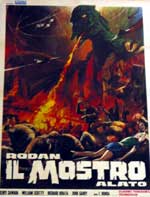 |
"Rodan,
the Winged Monster," reads the Italian title. A favorite poster format
for the kaijû eiga has a monster towering over an urban landscape
in the background, with frightened humans fleeing toward the viewer
in the foreground. This Italian poster offers a rather gruesome example,
showing more human carnage than most. The miniskirted (hot-panted?)
female at the bottom right provides one indication that the poster
art was created for a late-1960s rerelease of the movie, not for the
Italian debut of 1958. In Switzerland, some movie theaters used the
same publicity materials but superimposed on them a German title:
"Flying Monsters from Osaka." |
Poster #13
| FILM TITLE (JAPANESE): |
Kaijûtô no kessen: Gojira no musuko |
| (ENGLISH): |
Son of Godzilla |
| ORIGINAL YEAR OF RELEASE: |
1967 |
| POSTER NATIONALITY: |
Italy |
| YEAR: |
1969 |
| ARTIST: |
? |
| DIMENSIONS: |
approximately 39 x 55 inches |
| PRINTING METHOD: |
offset |
| MONSTERS FEATURED (LEFT TO RIGHT): |
Kamakirasu, Minya, Godzilla |
(from the collection of Gregory M. Pflugfelder) |
|
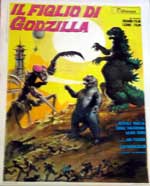 |
If Godzilla had a son, who was the
mother? This birds-and-bees question goes unanswered in the eight
Godzilla feature. The film's general naïveté is due in
part to its target audience: the preteen crowd that had been flocking
to see Daiei's Gamera series since 1965. Minya (or Minira, as he is
known in Japanese) is more cute than fearsome, although he apparently
shares the same radioactive breath as his father. The name of Minya's
insect foe, Kamakirasu, comes from the Japanese word for praying mantis, kamakiri (literally, "sickle-cutter"). English dubbers sought
to achieve the same effect by calling the oversized bugs "gimantises."
Similarly, the monstrous arachnid Kumonga who also appears in the
picture (but not in this poster) receives his name from the Japanese
word for spider, kumo. "Spiega" is his English-language
pseudonym. The searing sun and yellow sky that form a strikingly effective
background for the poster hint at the movie's plot, which revolves
around a series of weather-changing experiments gone awry. |
Poster #14
| FILM TITLE (JAPANESE): |
Kaijû sôshingeki |
| (ENGLISH): |
Destroy All Monsters |
| ORIGINAL YEAR OF RELEASE: |
1968 |
| POSTER NATIONALITY: |
Italy |
| YEAR: |
1969 |
| ARTIST: |
P. Franco |
| DIMENSIONS: |
approximately 55 x 77 inches |
| PRINTING METHOD: |
offset |
| MONSTERS FEATURED (LEFT TO RIGHT): |
Godzilla? (background), Godzilla, King Kong? |
(from the collection of Gregory M. Pflugfelder) |
|
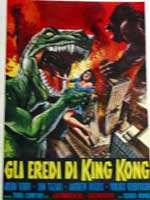 |
One of the most striking images in
the collection, this giant Italian poster draws heavily on the iconographic
legacy of King Kong (1933). Although no ape actually appears
in the 1968 film, the top right quadrant of the publicity poster features
a towering simian, teeth menacingly bared. The giant ape's appearance
echoes the film's Italian title, "The Heirs of King Kong," a canny
recognition of the earlier Hollywood movie's influence on international
cinema and on giant-monster films in particular. Facing toward the
viewer, rather than looking backward like the ape, is Kong's latter-day
successor, Godzilla. In another visual reference to King Kong, the
monstrous lizard hoists a Fay Wray-like (though in this case brunette)
female in midair, seemingly within reaching distance of his razor-sharp
teeth and oddly sensuous tongue. Notice the distinctly human, and
masculine, contours of the limb that holds her, which contribute to
the erotic charge of the image. |
SEE MORE OF THE EXHIBITION IN ROOM 2 and ROOM 3
Godzilla (R), all related characters and the character designs are trademarks
of Toho Co., Ltd.
© Gregory M. Pflugfelder

 Godzilla, King of the Monsters opened at Loew's State Theater in Times
Square on 4 April 1956, and ran for three weeks (see photograph at right).
"Several episodes are banzai-worthy," reported columnist and New York institution
Walter Winchell (U.S.
pressbook, 1956). Although in the previous year at least one Japanese-language
theater in Los Angeles had screened the original version of the film, Gojira (1954), the movie about which Winchell and others raved was an adapted version
tailored for U.S. and international audiences by Jewell Enterprises, whose
only previous hit was the 1952 Untamed Women
Godzilla, King of the Monsters opened at Loew's State Theater in Times
Square on 4 April 1956, and ran for three weeks (see photograph at right).
"Several episodes are banzai-worthy," reported columnist and New York institution
Walter Winchell (U.S.
pressbook, 1956). Although in the previous year at least one Japanese-language
theater in Los Angeles had screened the original version of the film, Gojira (1954), the movie about which Winchell and others raved was an adapted version
tailored for U.S. and international audiences by Jewell Enterprises, whose
only previous hit was the 1952 Untamed Women  ("SAVAGE BEAUTIES
WHO FEARED NO ANIMAL... YET FELL BEFORE THE TOUCH OF MEN!"). U.S. director
Terry Morse shot a day's worth of new footage, creating a role for Raymond
Burr—fresh from a "fine performance as the killer in 'Rear Window'
[1954]"—as an American news reporter who happens to be in Tokyo at
the time of Godzilla's assault (U.S.
lobby card, 1956). New York's first view of Godzilla would not be its
last. Kaijû sôshingeki (1968; Destroy All Monsters, 1969)
had Godzilla attacking midtown Manhattan from the East River (West
German lobby card, 1971). In 1976, the American distributors of Gojira
tai Megaro (1973; Godzilla vs. Megalon, 1976) poised the title
monsters atop the recently built World Trade Center—even though no
such scene appeared in the movie itself (U.S. pressbook, 1976). And in 1998,
TriStar Pictures would produce a thoroughly Americanized Godzilla,
starring Matthew Broderick, in which the giant lizard makes her (sic)
nest in Madison Square Garden.
("SAVAGE BEAUTIES
WHO FEARED NO ANIMAL... YET FELL BEFORE THE TOUCH OF MEN!"). U.S. director
Terry Morse shot a day's worth of new footage, creating a role for Raymond
Burr—fresh from a "fine performance as the killer in 'Rear Window'
[1954]"—as an American news reporter who happens to be in Tokyo at
the time of Godzilla's assault (U.S.
lobby card, 1956). New York's first view of Godzilla would not be its
last. Kaijû sôshingeki (1968; Destroy All Monsters, 1969)
had Godzilla attacking midtown Manhattan from the East River (West
German lobby card, 1971). In 1976, the American distributors of Gojira
tai Megaro (1973; Godzilla vs. Megalon, 1976) poised the title
monsters atop the recently built World Trade Center—even though no
such scene appeared in the movie itself (U.S. pressbook, 1976). And in 1998,
TriStar Pictures would produce a thoroughly Americanized Godzilla,
starring Matthew Broderick, in which the giant lizard makes her (sic)
nest in Madison Square Garden.

 From the very beginning, Godzilla was a global citizen. Within a year of
its American debut, Godzilla, King of the Monsters had played on
five continents as well as on both sides of the Iron Curtain (French
publicity flyer, 1957; Mexican
lobby card,
1959; Polish
theater program, 1957; Spanish herald,
1957?). It is unclear when the movie was first shown in Africa. Theaters
in Tunisia, however, were definitely screening French versions of kaijû
eiga by the late 1960s (Tunisian lobby cards, 1967). Kaijûtô no kessen: Gojira no musuko (1967; Son of Godzilla, 1969) is known to have played also in Egypt. A piece
of trivia: In the 1956 Godzilla, King of the Monsters, Raymond Burr's
character, Steve Martin, is on his way to Cairo on a journalistic mission
but gets
From the very beginning, Godzilla was a global citizen. Within a year of
its American debut, Godzilla, King of the Monsters had played on
five continents as well as on both sides of the Iron Curtain (French
publicity flyer, 1957; Mexican
lobby card,
1959; Polish
theater program, 1957; Spanish herald,
1957?). It is unclear when the movie was first shown in Africa. Theaters
in Tunisia, however, were definitely screening French versions of kaijû
eiga by the late 1960s (Tunisian lobby cards, 1967). Kaijûtô no kessen: Gojira no musuko (1967; Son of Godzilla, 1969) is known to have played also in Egypt. A piece
of trivia: In the 1956 Godzilla, King of the Monsters, Raymond Burr's
character, Steve Martin, is on his way to Cairo on a journalistic mission
but gets  delayed by the Godzilla crisis during a Tokyo stopover. Perhaps
if Martin had made it to Egypt, he would have witnessed the outbreak of
another incident of global proportions: the Suez Crisis, which erupted in
July of the same year.
delayed by the Godzilla crisis during a Tokyo stopover. Perhaps
if Martin had made it to Egypt, he would have witnessed the outbreak of
another incident of global proportions: the Suez Crisis, which erupted in
July of the same year.
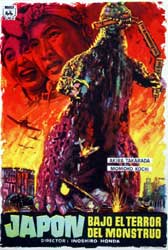
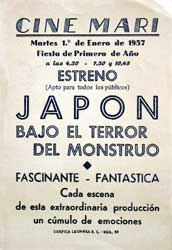
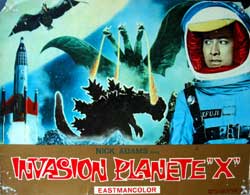

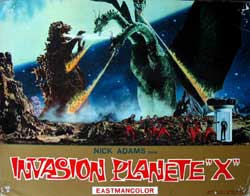
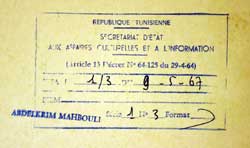
 Even monsters have friends (not to mention enemies). As the kaijû eiga genre boomed during the 1950s and 1960s, a growing stable of rubbery creatures
joined Godzilla in the movie-monster pantheon. The first newcomer was Angiras,
a spiny-backed saurian who faced the Big G in the 1955 film Gojira no
gyakushû (Gigantis, the Fire Monster, 1959; U.S.
lobby card, 1959; French
photostory, 1964). U.S. publicists chose to rename Godzilla "Gigantis"
when the movie premiered stateside, evidently hoping to create the impression
that the movie debuted two new monsters, not just one.
Even monsters have friends (not to mention enemies). As the kaijû eiga genre boomed during the 1950s and 1960s, a growing stable of rubbery creatures
joined Godzilla in the movie-monster pantheon. The first newcomer was Angiras,
a spiny-backed saurian who faced the Big G in the 1955 film Gojira no
gyakushû (Gigantis, the Fire Monster, 1959; U.S.
lobby card, 1959; French
photostory, 1964). U.S. publicists chose to rename Godzilla "Gigantis"
when the movie premiered stateside, evidently hoping to create the impression
that the movie debuted two new monsters, not just one. In 1956 came the
pterodactyl-like Rodan, the first Technicolor kaijû. Japanese
know this flying lizard even today as Radon—as in "radiation," the
destructive force that originally caused his portentous appearance (Japanese
poster reproduction). An alternative etymology derives the dinosaur-bird's
name from the prehistoric pteRADON. The film's exporters, possibly fearing
that the name Radon could be taken as a criticism of the U.S. atomic-weapons
program, changed it by switching the order of the vowels
In 1956 came the
pterodactyl-like Rodan, the first Technicolor kaijû. Japanese
know this flying lizard even today as Radon—as in "radiation," the
destructive force that originally caused his portentous appearance (Japanese
poster reproduction). An alternative etymology derives the dinosaur-bird's
name from the prehistoric pteRADON. The film's exporters, possibly fearing
that the name Radon could be taken as a criticism of the U.S. atomic-weapons
program, changed it by switching the order of the vowels (U.S.
lobby card,
1957). In North America, movies like Gigantis and Rodan, the
Flying Monster quickly became staple fare for drive-in theaters (U.S.
drive-in theater programs [1][2],
Florida, both 1959?). One theater owner in the South deemed Rodan appropriate Christmas viewing (U.S.
theater program, Florida, 1963?).
(U.S.
lobby card,
1957). In North America, movies like Gigantis and Rodan, the
Flying Monster quickly became staple fare for drive-in theaters (U.S.
drive-in theater programs [1][2],
Florida, both 1959?). One theater owner in the South deemed Rodan appropriate Christmas viewing (U.S.
theater program, Florida, 1963?).
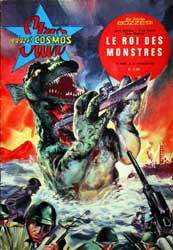
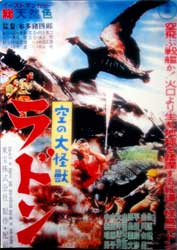
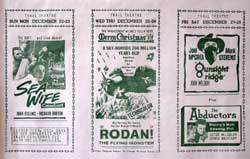
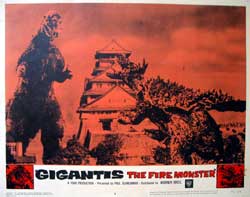
 It was as Rodan, not Radon, that German and other European, as well as Australian
and Latin American, viewers came to know the monstrous flying lizard (West
German theater program, 1958?). The perennially popular Mothra, who
debuted in 1961, was also a creature of many names. Italians called the
giant moth Watang (see Poster #11), whereas American promoters
dropped Mothra's name entirely from the 1964 feature Mosura tai Gojira,
retitling it Godzilla vs. the Thing and giving the behemoth butterfly
some rather unlikely tentacles in publicity materials (U.S.
lobby card and pressbook,
both 1964).
It was as Rodan, not Radon, that German and other European, as well as Australian
and Latin American, viewers came to know the monstrous flying lizard (West
German theater program, 1958?). The perennially popular Mothra, who
debuted in 1961, was also a creature of many names. Italians called the
giant moth Watang (see Poster #11), whereas American promoters
dropped Mothra's name entirely from the 1964 feature Mosura tai Gojira,
retitling it Godzilla vs. the Thing and giving the behemoth butterfly
some rather unlikely tentacles in publicity materials (U.S.
lobby card and pressbook,
both 1964).  The Tôhô universe was also populated by more forgettable creatures,
including Hedora the "Smog Monster," introduced in 1971 (U.S.
pressbook,
1972). The environmentalist message that this sludgelike mass helped to
convey ("Save the Earth" was the movie's rock-anthem theme song) marked
a shift away from the antinuclear themes of the 1950s and the critique of
commercialism that had dominated the kaijû eiga genre during the
1960s.
The Tôhô universe was also populated by more forgettable creatures,
including Hedora the "Smog Monster," introduced in 1971 (U.S.
pressbook,
1972). The environmentalist message that this sludgelike mass helped to
convey ("Save the Earth" was the movie's rock-anthem theme song) marked
a shift away from the antinuclear themes of the 1950s and the critique of
commercialism that had dominated the kaijû eiga genre during the
1960s.














